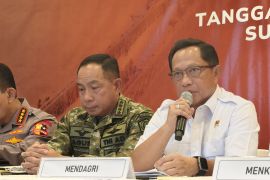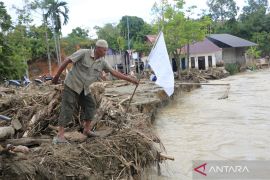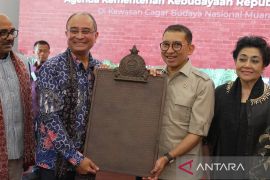This traditional wisdom remains omnipresent in Pagatan, Tanah Bumbu District of South Kalimantan, miles away from the homeland of the Bugis ethnic people in South Sulawesi.
Bugis women in Pagatan are skilled weavers. The existence of the Pagatan woven fabric has demonstrated their strong willingness to preserve the knowledge passed down from their ancestors and to reinforce their identity as Bugis people.
Bayani and Noorhayani are among the Bugis women in the village that have striven to preserve the culture of weaving.
Bayani has, until now, continued to use the wooden traditional weaving tool called "gedog" and remains resolute on not shifting to ATBM, or non-machinery weaving tool.
"You can see the result. It is much better to use gedog than ATBM," the 60-year-old woman remarked while displaying a piece of woven fabric bearing a peacock motif.
It takes some 20 days to create a piece of Pagatan woven cloth, measuring just 65 centimeters in width and four meters in length, using the gedog. Here, they can only apply two colors in a piece of cloth.
Weavers that use the ATBM take only a day or two to produce a piece of woven fabric measuring 1x2 meters in size.
Sharing the same opinion, Noorhayani, 40, admitted to having made all-out efforts to preserve the pearls of wisdom about the weaving technique handed down by her "nini" (grandmother) and "kai" (grandfather).
"I received knowledge on weaving from my grandfather. I learnt how to design a woven cloth from my grandmother since I was a kid," she recalled.
Noorhayani designs the fabric, colors the yarn, and inserts it in a tool called "sisir" before handing it over to weavers in her group.
She has four weavers in her group, including Bayani, but generally, only two weavers are active, especially during the harvesting period.
A Pagatan woven fabric is sold at Rp200 thousand to Rp800 thousand per piece based on the motif and material. Those made with gedog are priced higher than a cloth produced from ATBM.
In addition to traditional ornaments, weavers also weave to cater to customers' order and trends. Customers can decide on their choice of raw materials, such as cotton or silk.
As Bayani and Noorhayani insist on using gedog, mass production seems implausible in their business. She recalled having once obtained an order to produce 150 pieces of Pagatan woven cloth few years ago, and she had managed to finish it in a year.
"Although I already deployed all weavers in the village, but it yet took a year to complete the order," she stated.
Bugis migration
The existence of the Pagatan woven fabric is closely linked to the presence of the Bugis tribe, widely known as tough sailors in Kusan Hilir Sub-district, Tanah Bumbu District of South Kalimantan.
The Bugis of Wajo traders from South Sulawesi arrived in Pagatan in 1735, led by Puanna Dekke. They left their homeland in search of a better livelihood. The ruler of Banjar Kingdom gave permission to them to set up a kingdom, as Puanna Dekke could ensure the safety of water in Pagatan estuary that was frequently used as the pirates' "headquarters."
The area was named Kampoeng Pegattang, originating from the word Pemagatan or cutting rattan, and later changed to Pagatan. Kampoeng Pagattang was developed into a strategic small town, as it borders the Java Sea and is traversed by the Kusan River.
Although Bugis had long settled in Pagatan, they led a lifestyle akin to that in their homeland, including clothing and the tradition of weaving. When they migrated to South Kalimantan, most women in the family did not forget to bring along their weaving tools.
In the past, they only weaved to produce sarongs, a traditional costume of the Bugis.
The Tanah Bumbu district administration has encouraged weavers to produce other items of clothing and not solely restricted to sarongs. It also appealed to all civil servants in the district to wear woven Pagatan every Thursday in a bid to promote the traditional fabric.
Moreover, the move was aimed at encouraging more weavers in the area, especially members of the younger generation.
Noorhayani pointed to the trend of none of the girls in her family being keen to learn to weave or become weavers.
"They prefer to work in offices or stores," she noted.
In her neighborhood in Manurung Village, only five designers remain, with less than 20 weavers, most of them being elders.
The Pagatan woven fabric regained its lost glamour and popularity when President Joko Widodo wore the cloth in 2017 while attending the Mappanretasi, a ceremony to honor or give offerings to the sea as a sign of gratitude to God.
The president also dressed in the traditional fabric during a ceremony to mark the 72nd anniversary of Independence Day in 2017.
However Tanah Bumbu District Head Sudian Noor pointed to the lack of consistent quality becoming a challenge for producers of the traditional fabric.
"If we want to promote Pagatan woven fabric and boost its production, weavers would have to improve the quality of the product," he advised.
EDITED BY INE
Reporter: Sri Haryati
Editor: Eliswan Azly
Copyright © ANTARA 2019












